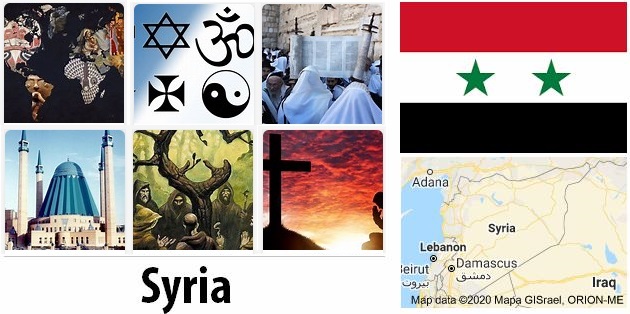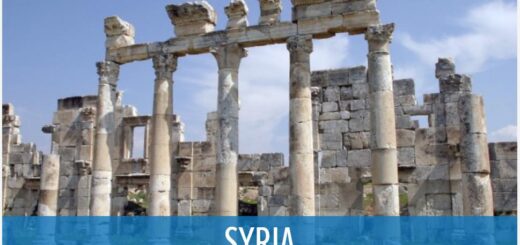Syria Religion
Although Syria is strongly dominated by Islam and religious issues have played a major role in its politics, the state has been formally secular (non-religious) ever since independence in 1941. The majority of Arabs, as well as most Kurds, belong to Islam’s main direction Sunni.
Syria, along with Lebanon, is the only Arab country that does not have Islam enrolled as a state religion in the constitution. However, according to the constitution, the head of state must be Muslim. Islamic law is supposed to be “a major source of legislation” under the Constitution, but in practice it has primarily been applied to Muslims in family matters (see Political system).
Sunni Muslim Arabs are Syria’s largest ethnic-religious group. Before the war, they made up about two-thirds of the population. Together, the Arab and Kurdish Sunni Muslims represented about three-quarters of the country’s population. The ruling minority, the Alawites (see Population) have their own interpretation of Islam. The Alawites themselves say that they profess Shia Islam, but historically many conservative Sunni Muslims have regarded them as heretics and even Shia Muslims have distanced themselves from them.
In Syria, there are also “ordinary” Shia Muslims (so-called Twelve Shia or Imamites) and several other minorities who have strong ties to Shia Islam. The largest of these groups are the Drusians who profess a religion that is a fusion of Islam, Christianity and popular beliefs. This group also includes ismailites (they confess to ismailiyya, the sect).
The historic split between Sunnis and Shi’a Muslims arose in a dispute over who would succeed Prophet Muhammad after his death in 632. Shi’am, “Ali’s party,” considered that Muhammad’s cousin and son-in-law, Ali, and his descendants were the only legitimate successors to the Prophet. Within Shia and Sunni, there are various law schools, and they partly celebrate different weekends. But it does not always, and not everywhere, give rise to conflicts.
- Countryaah: Population statistics for 2020 and next 30 years in Syria, covering demographics, population graphs, and official data for growth rates, population density, and death rates.
Other religions
In Syria, there is also a very small minority of Yazidis among the Kurdish-speaking groups in the northeast. It is a small peculiar religion which is otherwise mainly found in Iraq and the Caucasus. Sunni extremists in the Islamic State (IS) have exposed Yazidis to severe abuses.
Historically, there was also a Jewish minority, but the Jews have left the country for Israel or the United States as severe tensions have arisen as a result of the conflict between Syria and Israel over the Golan Heights occupied by Israel in 1967. In recent years, the remaining Jews in Syria have been no more than that they could be counted on their fingers.
Today, there are a wide range of Christian Catholic and Orthodox faiths; In addition, there are Maronites, Protestants and Assyrians / Nestorians. Under Ottoman rule (see Ancient History), many Christians converted to Islam because it could be advantageous both socially and economically. Many Christians have in modern times emigrated to Europe or North and Latin America. By having made up about one-eighth of the residents of Syria in the early 1900s, the proportion of Christians had dropped to almost one-twentieth before the war. Jehovah’s Witnesses were banned in 1964.
Increasing contradictions
Religious freedom was largely respected before the civil war that broke out in 2011, although there were problems with religious contradictions in politics and public discrimination in some contexts. Many Syrians were very proud of the country’s religious diversity before 2011 and – although aware that there were problems – wanted to highlight Syria as a positive example of religious coexistence.
Interest in Islam increased in the years before the war. This was evident, among other things, by the fact that more girls used shawls and more Syrians participated in the Friday prayer. The regime saw Sunni Islamist movements as a threat and mosques were monitored by the security service. To take the initiative of the Islamists, the regime increased its support for moderate forms of Sunni Islam and a number of new mosques were built. In 2008, and at an increasing rate from 2010, the regime resorted to radical Islamic pronouncements, especially at universities, and relocated or dismissed teachers, and banned female students from wearing a full veil.
The conflict that erupted in 2011 quickly gained religious prominence, with tensions especially between Sunni Muslims and Alawites. Most religious minorities supported the government, while the opposition was mainly supported by Sunni Muslims. As the crisis began to develop into armed conflict, Sunni Islamist groups gained influence among the rebels, while secular or religiously tolerant groups weakened. Today, the conflict appears as a religious civil war and the religious coexistence that prevailed before 2011 has collapsed. Many mixed areas have been cleared of deviant and the population has moved to areas dominated by their own religious group. Syria’s Sunni Muslims have suffered the worst of the war, especially because of the government’s bomb attack and the fact that it is mainly in Sunni areas that the war has taken place.
Although the government side is officially secular and is also supported by some Sunnis, the military’s special forces are dominated by Alawites. The army is also assisted by Shiite forces from Iraq, Lebanon and not least Iran. Many civilian opposition groups continue to preach religious cohabitation, but within the armed rebel movements, Sunni Islamists are strongest (except among the Kurds) and hostility toward Alawites and Shia Muslims seems very strong. Religious minorities have in many cases been subjected to massacres and deportations of rebel groups. The most extreme Sunni Islamists, such as supporters of al-Qaeda and the Islamic State (IS), describe Alawites as apostates from Islam and execute them if they are captured. The fact that IS largely consisted of entrapped jihadists from other countries, with brutal exercise of power.




